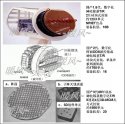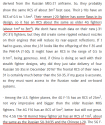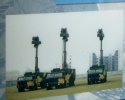I am very familiar with the bigger radome argument because it is probably the most often use. However there are many other factors and equally important such as :
a)packaging technology which determines number of TRs that can be packed within a given space;
Wrong. Its not packaging technology that determines that. Its sheer physics.
If elements are too close to each other, something called mutual coupling happens. This means radio waves from one element interferes and transfers to the next element, affecting the next element, causing a loss of efficiency and gain. To counter the effects of mutual coupling, the elements need to be separate each other.
How far can you separate the elements? If you go too far, it will result in grating lobes. To prevent grating lobes, the accepted rule is 1/2 (or just slightly over) of the frequency band used by the radar. The shorter the frequency, the shorter the spaces, the longer the frequency, the longer the space. A radar that works on a meter wavelength means the elements must be separated by half a meter from each other. Radar working on a 10 cm wavelength, means about 5 cm element separation, just for example.
Frequency used determines the distance and separation of the elements, and also of the density of the array.
b)quality of TR which drives duty cycle;
Duty cycle is determined by range of the target. Why?
Because the radar has to wait for the echo. The farther the target, the longer the radar has to wait for the echo. Only after it has received the echo can the radar transmit again. PRT is determined by range, the closer the target, the faster the pulses, the farther the object, the longer the pulses.
Mechanical fire control radars are capable of extremely fast pulse, for example, the radars used by CIWS that are used to track very close targets.
c)processing gain driven by quality of digital signal processors which the US leads in tech and the Chinese aspires to acquire;
5G is the state of the art when it comes to DSP use. Guess who is ahead.
The bigger the array, the more receiving elements, the greater the measurable difference between elements from one side to the other, up and down, left and right.
e)US "know how:' when it has been at this much longer
The same can be said of telecom and communication technology when the AT&T monopoly was the "Huawei" of the US.
Making an assumption that the J-15 will somehow have a more powerful radar simply on the basis of one factor is in my view rather selective.
A larger plane allows for a larger radome. That's not hard to understand. Its also the same advantage the F-15 has over the F-16.
The globalsecurity link has the SU-30MKI at 4 m2. Even giving you the benefit of the doubt, it is still 4X RCS advantage against the F-18 quoted at 1m2.
View attachment 53496
If I used the second link you provided it still had the F-18 at 1m2 and similar to the J-20 also rated at 1m2. LOL.
View attachment 53497
And what is an Su-35? Its still a Flanker, and a Flanker that is getting 1m2. At 2004, meaning this is older tech than an Su-35 today and the Su-35 at that time even had canards. It may even get lower if they decided to angle the radome, or do serration on the radome rim, or add grids on the cockpit glass. Further RCS reduction is possible if you attack the RCS on the AAMs and payloads.







